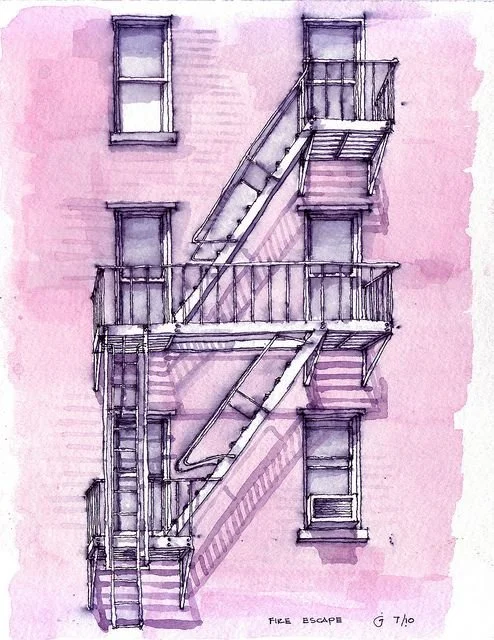Excerpts from “The Weight of Our Living: On Hope, Fire Escapes, and Visible Desperation”, written by Ocean Vuong, read by Halie Bahr
I keep finding myself looking up.
Attached to nearly every building a skeletal structure of architectural finesse.
Equal in my eyes. To any of the city's glittering towers. Fire escapes.
Not buildings exactly, but accessories. Iron rods fused into vessels of descent and departure.
Some were painted blue or yellow or green. But most were black.
Black staircases.
I could spend a whole hour sitting across the street from a 6 floor walkup studying the zigzags that clung to a building.
All of that richness and drama sealed away in fortress, whose walls echoed with communication of elemental or exquisite language.
And yet, only the fire escape.
A clinging extremity.
An adamant and often rusting. It speaks in its hardened exiled silence with the most visible human honesty.
We are capable of disaster and we're scared.
----
The first fire escape was developed in 1784 and was designed for personal use. This early model was simple. A rope attached to a window was anchored to the ground with a heavy wooden platform from which one could climb down and flee from a burning ledge. However, by the 21st century traditional iron fire escapes began to appear in America on the side of residential buildings, reducing the personal fire escape to obsolete. In its place a more collective means of escape was issued.
I don't know why I'm thinking of fire escapes. Part of me feels suddenly closer to them.
That sense of urgency and danger that fire escapes in their essence embody. Maybe this is why the collective fire escape has become so popular. Maybe I prefer such visible desperation to exist outside of my home, out of view, out of mind, but always there. While I go on with my daily life, the fire escape lies just a few feet away, dormant, conveniently hidden, but never completely. I gather my notions of terror and push it out the window.
Where it calcifies into a structure so utilitarian has to be a direct byproduct of fear itself.
And yet, as I walked through neighborhoods, there were always at least one or two fire escapes on each street adorned with flowers, tin bird feeders, herb gardens, pink lanterns, bike racks, and even cafe style chairs and tables. I admired and envied this act of domestication.
Imagine a pair of hands reaching between those cold black bars and placing a pot of lucent April tulips into the sun. Life touching the possibility of its extinguishment. It almost makes me forget what those black bars were intended for. And maybe that's for the better. Maybe we live easier decorating danger until it becomes an extension of our homes.
----
I wonder what would happen if I were to bring the fire escape back inside. In fact, what would the fire escape look like if I were to wear it on my person, my body, my personality, in public? And if I didn't have to apologize for it.
But I still have my body and with it these words hammered into the structure just wide enough to hold the weight of my living.
I want to leave the party through the window and find us standing on a piece of iron shaped into visible desperation.
Which must also be, and how could it not, the beginning of visible hope.
I want to stay there until the building burns down.
I want to love more than disaster can harm.
And I want to tell you this often.
That despite being so human and so terrified here, standing on this unfinished staircase to nowhere and everywhere at the same time surrounded by the cold and starless night.
We can live. And we will.


